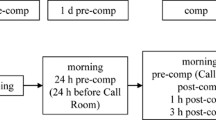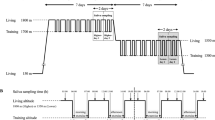Abstract
The aim of this study was to observe the influence of physical exercise and training on saliva cortisol concentrations in women. Three groups of adult women were studied: one group of sedentary controls (n = 7) and two groups of sportswomen who competed in either handball (n = 14) or swimming (n = 10) at a national level. These sportswomen gave six saliva samples during a day that included exercise which was part of their annual training programme. We noticed a significant increase in saliva cortisol concentration after exercise in the handball players (6 p.m. vs 7.30 p.m. P < 0.05) which did not appear in the swimmers or the sedentary group. There was no difference between the sedentary group and the swimmers for each sample of the day. These results showed that the type of sport played seemed to influence the concentration of saliva cortisol, the type of stress involved, the respective haemodynamic conditions of swimming and running and thermal stress also playing a part. Moreover, it seemed that the level of performance influenced the secretion of cortisol in the saliva.
Similar content being viewed by others
References
Alen M, Pakarinen A, Hakkinen K, Komi PV (1988) Responses of serum androgenic-anabolic and catabolic hormones to prolonged strength training. Int J Sports Med 9:229–233
Barron JL, Noakes D, Levy W, Smith C, Milliar P (1985) Hypothalamic dysfunction in overtrained athletes. J Clin Endocrin Metab 60:803–806
Creff AF (1988) Réponses hormonales à l'activité physique. Med Sport 62:72–78
Fellmann N, Bedu M, Giry J, Pharmakis-Amadieu M, Bezou MJ, Barlet JP, Coudert J (1989) Hormonal, fluid and electrolyte changes during a 72 h recovery from 24 h endurance run. Int J Sports Med 10:406–412
Fiet J, Passa Ph, Guechot J, Gourmel B, Villette JM, Cathelineau G (1981) Intérêt du dosage du cortisol dans la salive (abstract) Nouv Presse Méd 10:2664
Flynn MG, Pizza FX, Boome JB, Andres FF, Michaud TA, Rodriguez-Zayas RJ (1994) Indices of training stress during competitive running and swimming seasons. Int J Sports Med 15:21–26
Frenkl R, Csalag (1962) Effect of regular muscular activity on adrenocortical function in rats. J Sport Med Phys Fitness 2:207
Galbo H (1993) Hormonal and metabolic adaptations to exercise. Thieme, Stuttgart
Gharib C, Vincent N, Annat G, Allevard AM, Geelen G, Geyssant A, Eclache JP, Lacour R, Bizollon CA (1981) Activité rénine et aldosterone plasmatiques an cents d'un exercise submaximal. Effets de l'entraînement. J Physiol (Paris) 77:911–914
Guezennec CY, Defer G, Carzola G, Sabathier C, Lhoste F (1986) Plasma renin activity, aldosterone and catecholamine levels when swimming and running. Eur J Appl Physiol 54:632–637
Guezennec CY, Olivier C, Lienhard F, Seyfried D, Huet Fet Pesce G (1992) Hormonal and metabolic response to a pistol shooting competition. Science sports 7:27–32
Häkkinen P, Parakinen A, Alen M, Kauhanen H, Komi PV (1988) Daily hormonal and neuromuscular responses to intensive strength training in 1 week. Int J Sports Med 9:422–428
Hartley LH, Mason JW, Hogan RP, Jones LG, Kotchen TA, Mougey EH, Wherry FE, Pennington LL, Ricketts PT (1972) Multiple hormonal response to graded exercise in relation to physical training. J Appl Physiol 35:602–605
Kindermann W, Schnabel A, Schmitt WM, Biro G, Cassens J, Weber F (1982) Catecholamines, growth hormone, cortisol, insulin and sex hormones in anaerobic and aerobic exercise. Eur J Appl Physiol 49:389–399
Kirwan JP, Costill D, Flynn M (1988) Physiological responses to successive days of intensive training in competitive s7wimmers. Med Sci Sports Exerc 20:255–259
Künstlinger U, Lugwig HG, Stegeman J (1987) Metabolic changes during volley ball matches. Int J Sports Med 8:315–322
Kuoppasalmi K, Näveri H, Härkönen M, Adlercreutz H (1980) Plasma cortisol, androstenedione, testosterone and LH in running exercise of different intensities. Scand J Clin Lab Invest 40:403–409
Lac G, Lac N, Robert A (1993a) Steroid assays in saliva: a method to detect plasmatic contaminations. Arch Physiol Biochem Biophys 101:257–262
Lac G, Lac N, Robert A (1993b) Cortisol salivaire et activity sportive. Références particuliéres à l'enfant. Les Notes Scientifiques et Techniques de l'INRS, pp 55–67
Lenz T, Weiss M, Werie E (1988) Influence of exercise in water on hormonal metabolic and adregenic receptor changes in man. Int J Sports Med [Suppl] 9:125–131
Lukaszewska J, Wojcieszak I (1976) The effect of maximal exercise on plasma cortisol level in sportsmen. Wych Fiz Sport XX:22
Nielsen B, Spogard G, Bonde-Petersen F (1984) Cardiovascular, hormonal and body fluid changes during prolonged exercise. Eur J Appl Physiol 53:63–70
Raczynska B, Lukaszewska J, Wojcieszak I, Starosta A (1980) Influence de l'effort physique sur la sécretion du cortisol chez les sportifs de différentes disciplines. Med Sport T54:204–212
Seidman DS, Dolev E, Denster PA, Burstein R, Arnon R, Epstein Y (1990) Androgenic response to long-term physical training in male subjects. Int J Sports Med 11:421–424
Snegovskaya V, Viru A (1993) Elevation of cortisol and growth hormone levels in the course of further improvement of performance capacity in trained rowers. Int J Sports Med 14:202–206
Stray-Gundersen, Videman T, Snell P (1986) Changes in selected objective parameters during overtraining. Med Sci Sports Exerc 18:S54-S55
Tabata I, Atomi Y, Mutoh Y, Miyashita M (1990) Effect of physical training on responses of serum adrenocorticotropic hormone during prolonged exhausting exercise. Eur J Appl Physiol 61:188–192
Tharp GD, Buuck RJ (1974) Adrenal adaptation to chronic exercise. J Appl Physiol 37:720–722
Urhausen A, Kullmer T, Kindermann W (1987) A 7-week follow up study of the behaviour of testosterone and cortisol during the competition period in rowers. Eur J Appl Physiol 56:528–533
Ursin H (1980) Personality, activation and somatic health. Nato Conference series, pp 259–280
Vervoon C, Quist L, Vermust L, de Vries W, Thijssen J (1991) The behaviour of the plasma free testosterone/cortisol ratio during a season of elite rowing training. Int J Sports Med 12:257–263
Villanueva D, Magnani C, Ghini T (1986) Increased cortisol production in women runners. J Clin Endocrinol Metab 63:133
Viru A (1992) Plasma hormones and physical exercise. Int J Sports Med 13:201–203
Voigt K, Ziegler M, Fuchs M, Bickel U (1990) Hormonal responses to exhausting physical exercise: the role of predictability and controllability of the situation. Psychoneuroendocrinology 15:173–184
Author information
Authors and Affiliations
Rights and permissions
About this article
Cite this article
Filaire, E., Duché, P., Lac, G. et al. Saliva cortisol, physical exercise and training: influences of swimming and handball on cortisol concentrations in women. Europ. J. Appl. Physiol. 74, 274–278 (1996). https://doi.org/10.1007/BF00377450
Accepted:
Issue Date:
DOI: https://doi.org/10.1007/BF00377450




